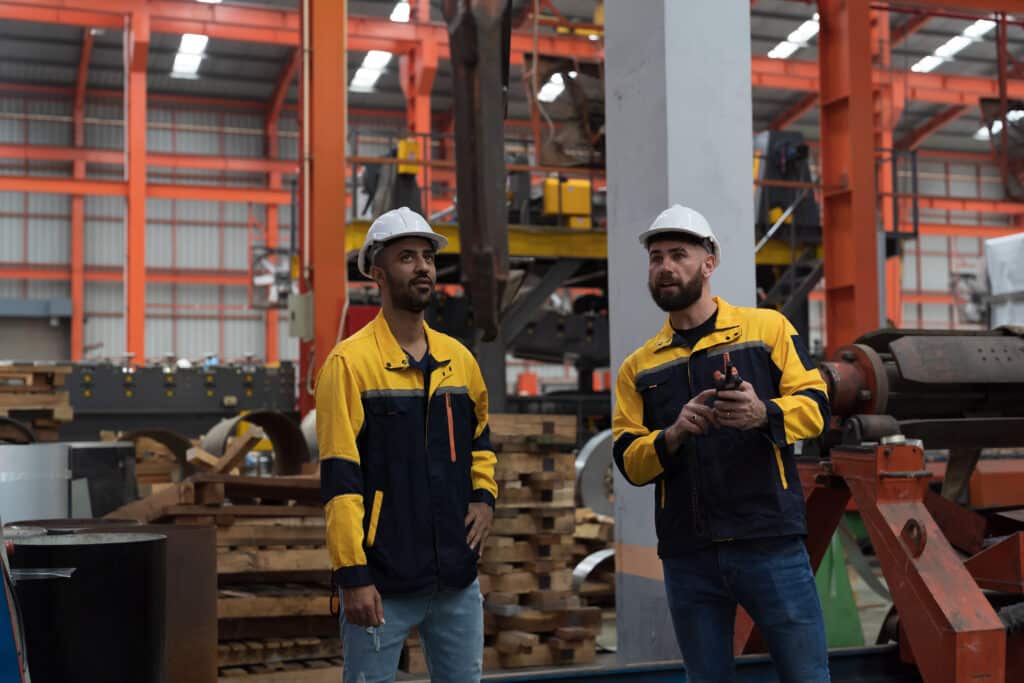Revolutionizing Manufacturing: The Role of Learning and Development
In the high-stakes realm of manufacturing, adaptation is ceaseless. Whether you’re producing automotive parts, high-tech gadgets, or sustainable materials, one thing is resoundingly clear — the industry’s heartbeat is the continuous evolution of skills. From frontline employees to upper management, learning and development (L&D) programs are the linchpin that separates the adaptable from the outmoded, the successful from the stagnant.
This comprehensive guide zeroes in on the pivotal role of L&D in the manufacturing sector. We’ll explore the trajectory of training in this industry from its humble origins to the high-tech initiatives that are shaping today’s factories, offer a closer inspection of the benefits reaped by manufacturers invested in training, dissect the challenges faced by HR and L&D managers in this sector, and provide a toolbox of best practices for a revolution in your training programs.


The Evolution of Learning and Development in Manufacturing
Learning and development in manufacturing is not merely a luxury; it’s a necessity. At every historical juncture, from the advent of the assembly line to the digital revolution, training programs have adapted to fuel progress. Today’s landscape is no different; it’s a digital ecosystem where virtual reality (VR), augmented reality (AR), and other cutting-edge technologies are not only transforming how things are made but also how people are trained to make them.
Historical perspective
In the infancy of manufacturing, on-the-job training (OJT) was the norm. New skills were transmitted from experienced workers to apprentices, often through hands-on guidance. The era of the Industrial Revolution marked the formalization of training as systems like apprenticeships and vocational schools took root to standardize essential trades.
Current trends and technologies shaping the landscape
Fast forward to today, and the advent of sophisticated automation tools, data analytics, and AI has become the new frontier of L&D in manufacturing. Simulated environments provide safe, controlled settings for skill acquisition. Elearning platforms are redefining accessibility, making training available anytime, anywhere. The rise of just-in-time learning ensures that the highly dynamic workforce of today can access the precise information they need at the moment they need it.
Current Challenges in Manufacturing Training
Bridging the Skills Gap
The manufacturing industry grapples with a critical shortage of skilled labor. Established professionals are aging out of the workforce, and there’s a faltering pipeline for incoming talent. This ‘skills gap’ poses a significant challenge for companies looking to maintain or expand their operations.
- Understanding the Gap: Identifying the precise areas where skills are lacking is the first step to bridging the divide.
- Root Causes of the Gap: Delve into reasons for the gap, including a lack of formal training, changing job requirements, and a perception gap among younger workers.
Technological Advancements and Automation
A relentless wave of technological advancements has fundamentally reshaped traditional job roles. Automation and robotics are no longer futuristic concepts but daily realities, redefining the nature of manufacturing work.
- Realigning Job Roles: New technologies require new skill sets. Realigning job roles through advanced training programs is essential for workforce readiness.
- Upskilling Current Workforce: Rather than replacing current workers, companies can invest in reskilling and upskilling to integrate new technologies effectively.
Compliance and Safety Requirements
Stringent safety regulations and compliance standards are non-negotiable in manufacturing, yet they frequently undergo updates and amendments. Maintaining a knowledgeable and compliant workforce is paramount.
- Dynamic Compliance Environments: Explore training methods that adapt to the rapidly changing landscape of compliance.
- Crisis Preparedness: Train for crisis situations proactively to minimize risk and maintain a safe work environment.
Key Benefits of Prioritizing Learning and Development
The investments that manufacturers make in L&D programs are not just about ticking checkboxes; they’re crucial to staying competitive.
Improved operational efficiency
Effective training means employees are profoundly familiar with their roles, leading to streamlined operations with fewer errors and less downtime. Here are some ways manufacturing L&D can help:
- Operational hazard awareness
- Efficiency best practices
- Proper use of equipment contributes to this critical advantage

Enhanced employee performance and engagement
Employees trained regularly and effectively are more productive and motivated. They are also more likely to feel a personal stake in the company’s success, contributing their full creativity and effort to their work.
Adaptation to technological advancements
With a manufacturing industry at the cusp of further digital transformation, Learning and Development lay the foundation for a flexible workforce able to capably handle new technologies as they emerge.
Challenges in Implementing Manufacturing Learning and Development Programs
Resistance to change
The manufacturing industry has a long-standing reputation for being conservative in embracing change. Traditionally, established methods and practices have been deeply ingrained, making it challenging to introduce new approaches, including in training and development. Some ways to convince leadership to invest in novel modes of training require a delicate balance of persuasion and evidence-based arguments, such as:
- Demonstrating a clear return on investment (ROI) is paramount, as decision-makers often prioritize tangible outcomes.
- Effective change management skills are essential to navigate the cultural shift towards embracing innovation in training methodologies. This entails not only presenting the benefits but also addressing concerns and fostering buy-in across all levels of the organization.
Budget constraints
In today’s manufacturing landscape, the rising costs associated with training present a significant challenge, particularly as budgets become increasingly constrained. As a result, manufacturers are forced to seek ways to maximize the efficiency and effectiveness of their training initiatives. This requires a proactive approach to resource allocation, where every dollar spent must yield substantial value.
Innovative solutions are indispensable in this regard, whether it be leveraging technology for cost-effective training delivery, implementing scalable training models, or exploring partnerships and collaborations to share resources and reduce expenses. Furthermore, L&D program design must be meticulously crafted to optimize the utilization of available funds while still meeting the diverse learning needs of employees.
Skill gaps and training needs assessment
Navigating the dynamic landscape of manufacturing necessitates adept strategies for identifying and addressing skill gaps within the workforce. This perpetual challenge demands comprehensive approaches to conducting skills gap analyses, anticipating future training needs, and implementing effective training interventions. Key considerations include assessing current competencies, anticipating industry trends, and fostering adaptability:
- Conducting comprehensive skills gap analyses to pinpoint areas requiring training interventions
- Assessing both current competencies and future needs, considering industry trends and technological advancements
- Anticipating future training requirements with foresight and agility to adapt swiftly
- Implementing robust mechanisms for ongoing assessment and feedback to ensure program relevance and effectiveness
Best Practices and Strategies for Effective Learning and Development
The way forward in manufacturing learning and development in manufacturing is not to simply do more of the same but to do it smarter. These are the best practices and strategies to future-proof your training programs.
Blended earning approaches
Combining traditional classroom instruction with digital elements provides a hybrid solution that appeals to diverse learning styles and ages. Interactive elearning complements hands-on experience in a way that maximizes both effectiveness and efficiency.
Continuous upskilling and reskilling
The pace of technological change means L&D programs must be continuous and broad-reaching. A proactive approach to upskilling and reskilling means employees are always prepared for the next advancement or challenge.
Performance tracking and assessment
Rigorous tracking of training activities and outcomes is essential. Modern learning management systems support real-time performance assessment, enabling immediate feedback that can guide further learning activities.
Measuring Training Effectiveness
Key performance indicators (KPIs)
By establishing KPIs, organizations can measure the impact of training on broader business objectives.
- KPI Examples: Look at specific KPIs like production output, error reduction, or machine uptime to gauge training effectiveness.
- Aligning KPIs with Business Goals: Ensure the KPIs chosen directly contribute to the company’s strategic objectives.
Feedback mechanisms
Constructive feedback from trainees and supervisors is invaluable for refining training methodologies.
- Surveys and Focus Groups: Regularly conduct anonymous surveys and host focus groups to gather candid feedback.
- Continuous Improvement: Be agile in responding to feedback, using it to iteratively improve training programs.

Assessment Tools
Regular assessments validate learning and help determine the need for further training or skill refinement.
- Formative Assessments: Implement an ongoing assessment strategy that benchmarks progress and identifies areas of improvement.
- Summative Assessments: At specific milestones, use summative assessments to validate learning and certify proficiency.
Conclusion
The imprint of learning and development on the manufacturing sector is indelible, with evidence suggesting that a commitment to training is not just good for employees; it’s good for business. By leveraging the full arsenal of educational tools available, manufacturers can equip their teams to meet the challenges of tomorrow with unwavering confidence and capability.
Now is the time for manufacturers to seize the potential of L&D. With a proactive stance on advancing skills, the industry can not only fill its talent gaps but also carve a distinct and sustainable niche in the market. Ready to revolutionize your approach to training?
Leading educational institutions are inspiring learning with Echo360.

















